Article Archive
Hermès
Eau de Citron Noir
2 July, 2018
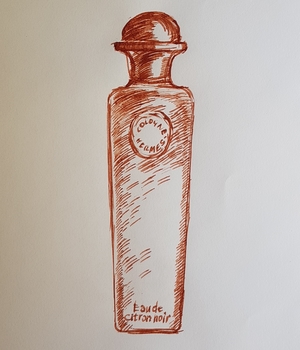 I’ve always loved eau de cologne. There’s nothing like the exhilarating zing of citrus to start your day, especially in sultry weather. The classic cologne such as 4711 Kölnisch Wasser, with its mix of citrus fruits, lavender, rosemary and neroli oil, is a well-nigh perfect (if all-too-evanescent) formulation, but over the years many perfumers have tried their hand at adding their own individual twist, with greater or lesser success.
I’ve always loved eau de cologne. There’s nothing like the exhilarating zing of citrus to start your day, especially in sultry weather. The classic cologne such as 4711 Kölnisch Wasser, with its mix of citrus fruits, lavender, rosemary and neroli oil, is a well-nigh perfect (if all-too-evanescent) formulation, but over the years many perfumers have tried their hand at adding their own individual twist, with greater or lesser success.
At Guerlain, for example, each generation of perfumers has created their own cologne, and the brand’s range of Les Eaux includes some wonderful reinterpretations such as Jacques Guerlain’s Eau de Fleurs de Cédrat from 1920, or current perfumer Thierry Wasser’s delicious Cologne de Parfumeur from 2010, which adds modern musks and a touch of cedar to the formula.
Hermès launched its first eau de cologne in 1979, with Françoise Caron’s superb Eau de Cologne d’Hermès, which was renamed Eau d’Orange Verte in 1997. For me it’s up there with Dior’s Eau Sauvage and Guerlain’s Vetiver as one of the greatest men’s perfumes around, and I’d expect that it remains their best-selling cologne. In 2009, though, Jean-Claude Ellena started expanding the range, with Eau de Gentiane Blanche and Eau de Pamplemousse Rose, followed in 2013 by Eau de Narcisse Bleue and Eau de Mandarine Ambrée.
Hermès released two more colognes in 2016, marking the handover between Jean-Claude Ellena and his successor as in-house perfumer, Christine Nagel. Ellena’s Eau de Neroli Dorée is a superb celebration of the scent of orange blossom, while Nagel’s Eau de Rhubarbe Ecarlate is fruity and great fun.
Her latest addition to the range is Eau de Citron Noir, which takes lime rather than lemon as its starting point. And not just any lime: the black lime of its name refers to the charcoal-black sun-dried limes you can buy in Oman, where they’re ground up and used as a spice. Nagel credits my fellow perfume blogger Persolaise for introducing her to this ingredient, which shows how important good blogs have become for the industry itself. Black limes give an earthy, rather sour taste to food, and lack the sweetness of fresh limes – but they also have a touch of smokiness, which Nagel has tried to recapture in her cologne.
As a fan of colognes in general and lime in particular, Citron Noir should be right up my street. And it is – at least to start with. As with most colognes, its initial, zesty burst of citrus quickly fades away, to be followed by Nagel’s recreation of the unusual fresh-but-smoky scent of black lime, which still (to me at least) has a bit of fruitiness about it. Unfortunately that’s where I get off, if I can put it that way: on my skin the fruitiness seems to turn slightly sour after a while, and that’s not what I’m looking for in a cologne. On the other hand it makes a fantastically invigorating shower gel, since its initial lime freshness has no time to disappear.
Lalique
Encre Noire à l’Extrême
18 November, 2016
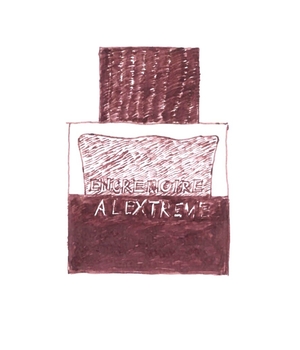 Lalique has been associated with perfume since 1907, when its founder, René Lalique, began to produce alluring glass bottles for the prodigiously entrepreneurial French perfumer François Coty. But it wasn’t until 1992 that the company launched a perfume of its own with Lalique de Lalique.
Lalique has been associated with perfume since 1907, when its founder, René Lalique, began to produce alluring glass bottles for the prodigiously entrepreneurial French perfumer François Coty. But it wasn’t until 1992 that the company launched a perfume of its own with Lalique de Lalique.
Encre Noire – literally ‘black ink’ – was released in 2006, and was quickly hailed as one of the best vetiver scents around. Created by the talented perfumer Nathalie Lorson from the Swiss fragrance-and-flavour firm Firmenich, it blends good-quality vetiver (whose earthy, slightly bitter smell comes from the roots of a tropical grass) with the woody notes of cypress and a long-lasting synthetic called Cashmeran, whose effect is as plush as its name.
Though Encre Noire is still available, and presumably a steady seller, Lalique has celebrated its 10th anniversary by launching a slightly more powerful, punchy version called Encre Noire à l’Extrême. Created again by Nathalie Lorson, the new perfume blends two different vetivers, one from Haiti and the from Java, and adds touches of iris, incense, sandalwood and patchouli.
If rather stronger and heavier than the earlier Encre Noire, it’s still a very attractive fragrance, and while Lalique claims that Encre Nore à l’Extrême ‘redefines masculinity’, we feel that it would smell equally appealing on a man or a woman. Think ink.
Hermès
Eau de Néroli Doré and Eau de Rhubarbe Eclarate
11 November, 2016
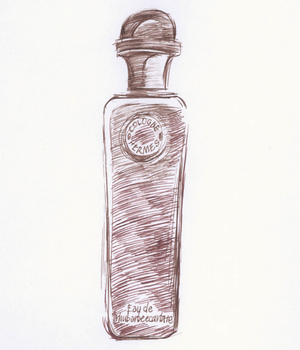 In spring 2016, after ten years as Hermès’ in-house ‘nose’, Jean-Claude Ellena handed over the (no doubt luxuriously designed) reins to the Swiss-Italian perfumer Christine Nagel. Hermès celebrated the handover with two new additions to its Colognes range, one by Ellena and the other by Nagel – her first perfume for the brand.
In spring 2016, after ten years as Hermès’ in-house ‘nose’, Jean-Claude Ellena handed over the (no doubt luxuriously designed) reins to the Swiss-Italian perfumer Christine Nagel. Hermès celebrated the handover with two new additions to its Colognes range, one by Ellena and the other by Nagel – her first perfume for the brand.
Ellena’s Eau de Néroli Doré is a fittingly sumptuous sign-off from this much-lauded perfumer, using high concentrations of neroli oil, extracted from the flowers of the Seville orange tree. It’s as refined and elegant as the man himself, and like most of his fragrances it also contains an ingredient more often associated with food. In this case it’s saffron, which (to my nose at least) seems to give the perfume an added touch of smoothness and sheen.
Christine Nagel’s Eau de Rhubarbe Eclarate, by contrast, is an exercise in sheer vivacity and ebullience, using the smell of freshly-cut rhubarb and extending its longevity with the soft, refined scent of modern synthetic musks. It’s fruity and sweet and instantly appealing, more emotional than intellectual, but certainly great fun. With its ruby-red bottle it’s a real pick-me-up at the start of the day; save the golden Eau de Neroli Doré for later.
Elie Saab
Essence No 6: Vetiver
29 November, 2015
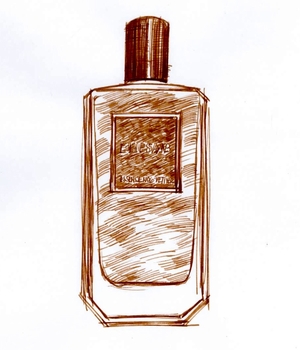 Is it just me, or would you be more impressed if a successful fashion designer decided not to do a perfume range than decided to do one? But there we are: perfume and fashion have gone together since the days of Paul Poiret, and you can’t blame Elie Saab from joining the crowd.
Is it just me, or would you be more impressed if a successful fashion designer decided not to do a perfume range than decided to do one? But there we are: perfume and fashion have gone together since the days of Paul Poiret, and you can’t blame Elie Saab from joining the crowd.
Actually perhaps that’s a bit unfair, as Saab’s new perfume, Essence No 6: Vetiver, is a really fine unisex fragrance, cleverly balancing the slightly damp earthiness of vetiver with the woody, floral scent of violet and herbal lavender.
There again maybe I shouldn’t have been surprised, as like all of Saab’s fragrances, Vetiver is the work of Francis Kurkdjian, who is now arguably the leading perfumer of his generation. French-born Kurkdjian sprang to fame at the age of 26 when he created Le Male for Jean-Paul Gaultier, and he has gone on to launch a stream of commercial hits, from Armani Mania to My Burberry. Yet he’s remained a highly creative perfumer, with his own excellently packaged Maison Francis Kurkdjian line.
In 2010 Saab signed a ten-year deal with Beauté Prestige International, one of the big perfume licensing companies (which in turn is owned by Shiseido), and the first Elie Saab perfume came out the following year. The Essences range was launched in August 2014, and Essence No6: Vetiver is the latest addition, along with Essence No7: Neroli (funnily enough there isn’t an Essence No5 in the range, presumably for Chanel-related reasons).
Vetiver has long been one of the most popular ingredients in perfumery, particularly in men’s perfumes. It’s not hard to understand why: the dried roots of this tropical grass have a wonderfully earthy, sexy, slightly bitter smell. You could probably use good-quality vetiver oil as a scent in its own right, but understandably enough, creative perfumers enjoy the challenge of combining it with other ingredients to bring out its specific qualities. In Guerlain’s classic Vétiver, for example, it’s combined with the lemony citrus smells you’d expect to find in a men’s cologne.
For Essence No6: Vetiver, perfumer Francis Kurkdjian has done something a bit different, by softening the earthy vetiver with the gentler, less abrasive scents of lavender, cloves, geranium and bergamot orange. Together they give Essence No6 a gentle touch of fruit, and even a hint of chocolate, though vetiver remains the star of the show. The result is deliciously rich and rounded, and you can really sense the quality of the ingredients. The chunky glass bottle, too, has an appealing weight to it, helped by the attractively unfussy, rather retro design, like a men’s after-shave from the 1930s. Perfect for wearing every day.
Hermès
Equipage Géranium
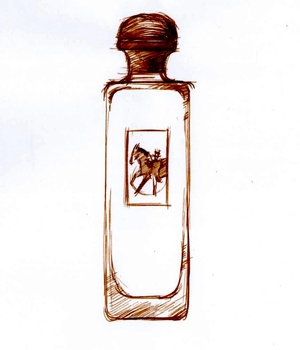 Equipage is such a classic perfume that it’s tempting to ask why anyone would mess with it, but that’s a bit like wondering why anyone would want to reinterpret the Beatles’ original version of Yesterday.
Equipage is such a classic perfume that it’s tempting to ask why anyone would mess with it, but that’s a bit like wondering why anyone would want to reinterpret the Beatles’ original version of Yesterday.
Created by the perfumer Guy Robert and launched in 1970, Equipage was the first Hermès perfume to be designed specifically for men, and Robert composed a rich, subtly spicy scent which includes – among many other things – bergamot orange, jasmine, lily of the valley and clove-scented carnations.
Forty-five years on, the company’s in-house perfumer, Jean-Claude Ellena, has revisited three of its classics, in each case pairing them with a new ingredient. First came Bel Ami Vétiver, followed by Rose Amazone, and now we have his updated version of Equipage – Equipage Géranium.
If Ellena’s attempt to give Equipage a modern twist isn’t (to my nose at least) entirely successful, his choice of geranium (or pelargonium, to be botanically correct) as a new ingredient is a typically clever and imaginative one. Though the leaves of different species of pelargonium smell of everything from lemon to cinnamon, most of the so-called geranium oil used in perfumery comes from a single South African species, Pelargonium graveolens. As with all natural ingredients, geranium oil comes in a range of different grades, but they generally share a fresh, slightly sharp smell that’s usually described as both fruity and minty, often with a hint of rose.
I’m guessing that it was the fresh, minty element of geranium oil that appealed to Jean-Claude Ellena, and Equipage Géranium does smell a tiny bit fresher and sharper than the original Equipage – but it’s a subtle twist rather than a radical reinvention. I’m not sure it’s sufficiently different to make it worth choosing over the original, but unlike many of Ellena’s perfumes, which are always refined but sometimes stripped down until they’re slightly colourless, Equipage Géranium retains all the richness and complexity of its inspiration. Given the crude simplicity of so many modern scents, that’s a quality to be celebrated.
Lalique
Encre Noire
15 April, 2015
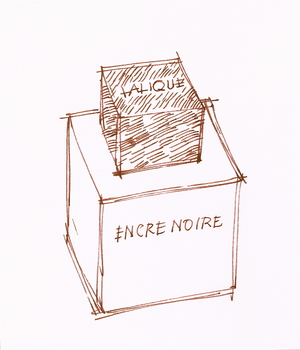 Calling a perfume ‘black ink’ has intriguing connotations. ‘Black’ or ‘Noir(e)’ has been the perfume industry’s shorthand for ‘edgy’ ever since the 1998 launch of the striking but hard-to-wear Bulgari Black. Among the many followers in its wake we’ve had Ambre Noir, 1881 Black, Armani Privé Cuir Noir, Bois Noir, Coco Noir, Cologne Noir, Dahlia Noir, Datura Noir, Eau Noir, Fourreau Noir, even (I kid you not) Hello Kitty Noir.
Calling a perfume ‘black ink’ has intriguing connotations. ‘Black’ or ‘Noir(e)’ has been the perfume industry’s shorthand for ‘edgy’ ever since the 1998 launch of the striking but hard-to-wear Bulgari Black. Among the many followers in its wake we’ve had Ambre Noir, 1881 Black, Armani Privé Cuir Noir, Bois Noir, Coco Noir, Cologne Noir, Dahlia Noir, Datura Noir, Eau Noir, Fourreau Noir, even (I kid you not) Hello Kitty Noir.
So Encre Noire (which was launched in 2006) follows a bit of a bandwagon, though at least its name is better than most. It’s a nostalgic name, since hardly anyone uses ink (black or otherwise) these days, yet it’s evocative too – I can kind of imagine the smell of black ink, even though I must have been a teenager the last time I opened an actual bottle of the stuff.
Whatever you think about the name, Encre Noire is a fine addition to the many men’s perfumes to be based on the smell of vetiver, the vigorous tropical grass whose roots have a wonderful dry, earthy, slightly musky scent. My all-time favourite is Guerlain’s simply-named Vétiver, which starts with a burst of lemony freshness, but Encre Noire foresakes such tricks and sticks resolutely with vetiver all the way through.
I say ‘all the way through’, but of course it’s actually a bit more complicated than that, thanks to Nathalie Lorson, senior perfumer at the giant Swiss fragrance company Firmenich. When she created Encre Noire she cleverly smoothed off some of vetiver’s rough edges, adding tiny amounts of cypress extract (which has a dry, woody, slightly resinous smell), as well as synthetic musk and so-called ‘cashmere wood’. This is actually 2,3,5,6,7-hexahydro-1,2,3,3-pentamethyl-4h-inden-4-one, a chemical sold under the brand name of Cashmeran, which is widely used in perfumery (and household products) and has a soft, gently woody smell.
The final result an appealing and long-lasting perfume, though some people are always going to find vetiver too dry and bitter-smelling for their taste. As for the bottle, a black glass cube with a square wood-effect cap, I like its inkwell look, but its glossy surfaces all too quickly get smeared with fingerprints, and the lettering is so spare – just a bare ENCRE NOIRE in thin white sans-serif capitals – that (to me at least) it ends up looking a bit cheap and half-considered, though I’m sure it was anything but.
Minor gripes aside, this is a fine perfume, and even if, in the end, I think it’s unlikely to supplant Guerlain’s Vétiver in my affections, I think its popularity is well deserved.
Annick Goutal
Eau de Monsieur
26 March, 2015
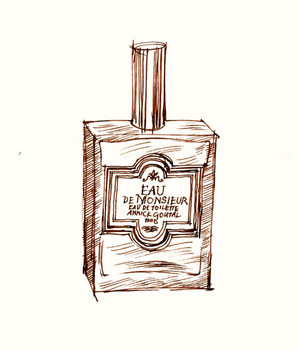 Mention the name Annick Goutal and the first scent that springs to mind is Eau d’Hadrien, the intensely lemony, slightly hair-sprayish scent that was launched in 1981 and went on to become the company’s best-seller.
Mention the name Annick Goutal and the first scent that springs to mind is Eau d’Hadrien, the intensely lemony, slightly hair-sprayish scent that was launched in 1981 and went on to become the company’s best-seller.
But before Eau d’Hadrien came Eau de Monsieur. Launched in 1980, discontinued for a while and then relaunched in 2013, it shares its lemony, eau de cologne-like zest with Eau d’Hadrien, but it’s an altogether quieter, softer fragrance.
Eau de Monsieur, like Eau d’Hadrien, is based around the zesty, zingy smell of lemons and the slightly pear-drop-lemony sweetness of lemon verbena (extracted from the leaves of a straggly South American shrub).
But while that’s pretty much the start and the finish of Eau d’Hadrien, that initial burst of sharp sweet freshness quickly fades to reveal what smells a bit like a sun-drenched Greek mountainside underneath – that scent of crushed thyme, cistus leaves and lavender, which in this case has an added touch of helichrysum, that strong-smelling everlasting flower that the French call immortelle.
Immortelle isn’t a scent that everybody loves: to me it has the richness of brandy and Christmas pudding and crackling pine-log fires, but to other people it has a medicinal TCP smell, which isn’t something you necessarily want in a perfume.
In Goutal’s fantastic Sables, released a few years later in 1985, immortelle is the main ingredient, but in Eau de Monsieur it’s used in moderation to give a subtle background sweetness. According to the list of ingredients on the Annick Goutal website, it also includes patchouli and sandalwood, which add a bit of their gentle warm woodiness to the mix, and there’s a little bit of bitterness too, which other writers have ascribed to that classic men’s-fragrance ingredient, vetiver.
It’s not, perhaps, the most original perfume out there, and it’s disappointing to discover that it only last an hour or so on the skin, but Eau de Monsieur is classy, attractive, natural-smelling and easy to wear, which is a lot more than you can say for the majority of men’s fragrances.
Comme des Garçons
Eau de Parfum
12 November, 2014
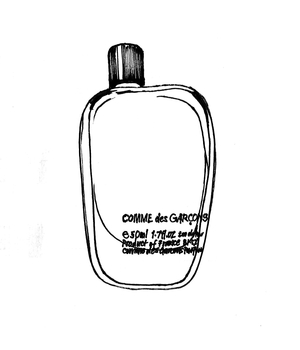 Christmas is coming, and as a long-standing fan of over-indulgence I’m thoroughly looking forward to getting fat on Christmas pudding with brandy butter, washed down with a large glass of Harvey’s Bristol Cream, ideally in front of a roaring log fire. Alternatively I could just blow my own socks off with a generous splash of Comme des Garçons’ delicious Eau de Parfum a.k.a. Christmas in a bottle.
Christmas is coming, and as a long-standing fan of over-indulgence I’m thoroughly looking forward to getting fat on Christmas pudding with brandy butter, washed down with a large glass of Harvey’s Bristol Cream, ideally in front of a roaring log fire. Alternatively I could just blow my own socks off with a generous splash of Comme des Garçons’ delicious Eau de Parfum a.k.a. Christmas in a bottle.
Launched in 1994, this was the Japanese cult fashion brand’s first foray into perfume, but if there was nothing unusual about that, it’s rare for a first perfume to make such a big impression. Partly it was the design of the bottle, a slightly egg-shaped oval with an off-centre cap and no obvious way to stand it up.
That might sound a bit annoying, but I think it’s one of the most stylish and sophisticated perfume-bottle designs of the last 20 years. Eccentric it may be, but Comme des Garçons founder Rei Kawakubo’s design is so sleek and refined that it makes most other perfume bottles look cheap and tawdry by comparison.
The Sniff Box is about the scent, though, and what a scent this is. Created by Derby-born perfumer Mark Buxton, it’s not for the shy or faint of heart, for this is one of those fragrances that carries everything (and everyone) before you. The first thing you smell is cloves – or rather clove oil: in fact this is a distinctly oily concoction, for among the other ingredients are nutmeg oil, cinnamon-bark oil, cardamom oil, geranium oil and coriander oil. To me it even feels slightly oily on the skin, which gives it an added touch of luxury and also sets it apart from the vast majority of alcohol-based fragrances.
With ingredients like those it could hardly be anything other than spicy, but Mark Buxton cleverly added a touch of the resinous, smoky smell of incense with cedarwood, labdanum and styrax. The result is wonderfully rich and strange, and though some people find it overpowering, to be overpowered like this is like drowning in a butt of Malmsey: what a way to go!
Hermès
Eau de Narcisse Bleu
10 October, 2014
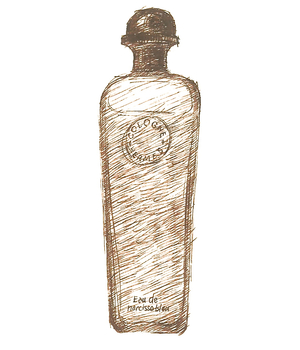 Pretty much everyone I know loves Hermès’ deliciously fresh and zingy Eau d’Orange Verte, so when Eau de Narcisse Bleu (literally ‘blue narcissus water’) was launched in 2013 it had a tough act to follow. As I’ve never seen a blue narcissus / daffodil, I think it’s safe to say that this perfume has an element of fantasy about it, and as a smell, too, it’s perhaps rather more complex and a little less instantly accessible than its predecessor. But give it a little time and I think it’ll grow on you.
Pretty much everyone I know loves Hermès’ deliciously fresh and zingy Eau d’Orange Verte, so when Eau de Narcisse Bleu (literally ‘blue narcissus water’) was launched in 2013 it had a tough act to follow. As I’ve never seen a blue narcissus / daffodil, I think it’s safe to say that this perfume has an element of fantasy about it, and as a smell, too, it’s perhaps rather more complex and a little less instantly accessible than its predecessor. But give it a little time and I think it’ll grow on you.
Eau de Narcisse Bleu may not have the euphoric mood-lifting freshness of Eau d’Orange Verte, but it has a gentle softness that, once you’ve smelled it for a while, is extremely appealing in its own right. It does have the faint sweetness of real daffodil flowers (try sticking your nose in one on a sunny day next March and you’ll see what I mean), but what narcissus extract smells of most, rather unexpectedly, is fresh hay. *
Now, I have nothing against smelling of hay, which is a lovely scent in its own right, but what Hermès’ much-mythologised perfumer, Jean-Claude Ellena, has done is blended the smell of hay with a whole raft of subtly complementary fragrances. Most of them are quite ‘green’ – that is, they smell fresh and natural, like grass and leaves, but not especially sweet or flower-like.
To me it has a slight but definite scent of fig-leaves, which for anyone who loves L’Artisan Parfumeur’s wonderful Premier Figuier as much as I do can only be a good thing. Whether this figginess is (excuse the pun) a figment of my imagination I’m not sure, but among the other ingredients that Ellena lists is galbanum, which is extracted from the root of a wild Iranian plant that looks a bit like fennel or cow-parsley, and indeed is distantly related to them.
Galbanum has a marvellously fresh sappy smell like newly-snapped pea-pods, and is one of the most important components of ‘green’ perfumes, but its greenness, here, is tempered by the hay-like sweetness of narcissus, with a hint of earthy bitterness underneath which manages to stop it from smelling at all girly.
If my description makes it sound a bit complicated, don’t be put off, for it’s such a well-blended perfume that there’s nothing discordant about it. In fact if anything it is, perhaps, a little too gentle for its own good, as it’s a ‘quiet’, thoughtful scent that stays close to your skin and doesn’t, on the whole, grab other people’s attention. It’s discreet and refined, in other words, rather than a ‘look-at-me’ perfume, which is perfect if you want to smell good without drawing attention to yourself. Go try it.
* I say ‘narcissus extract’, but one of the irritating things about perfume marketing is how vague – and frankly clueless – most descriptions of perfume ingredients actually are. For as anyone who actually grows the things themselves knows full well, a bright-yellow daffodil like Narcissus ‘February Gold’ smells very different to Narcissus papyraceus, the so-called paperwhite narcissus; the former has a gentle, hay-like scent, while one of the big selling-points of paperwhites is their powerful, almost jasmine-like perfume, the sweetness of which, en masse, can have a touch of the slightly repellent stagnant-water smell that perfumers refer to as ‘indolic’. If only perfume PRs were taught some basic botany.
Postscript – mystery solved, but only by going to the source: in France last week I visited IFF-LMR, the legendary natural raw perfume materials company near Grasse, and what should we get talking about but their narcissus extract, which is derived from the beautiful Narcissus poeticus, fields of which grow wild in the uplands of the Lozère. Did they use other species of daffodil as well? No, came the answer, and it’s their extract that you’re smelling (among many other things) in Eau de Narcisse Bleu.
Chanel
Egoïste
22 July, 2014
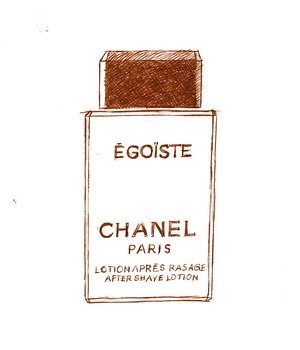
The first thing I think when I smell Egoïste is ‘spicy!’ It’s a big, bold, in-your-face fragrance, well-suited to its name, which doesn’t suit everyone – in fact I’ve never thought it really suited me. But if you have the confidence to carry it off it’s a superb perfume of its kind.
Egoïste was created by Chanel’s long-standing in-house perfumer, Jacques Polge, and released in 1990 with the kind of blitzkrieg advertising that Chanel does so well. Possibly too well, since I suspect that fewer people remember the perfume than Jean-Paul Goude’s brilliant film, in which a bevy of deranged-looking models screamed ‘Egoïste!’ while slamming open and shut the blinds of a scaled-down version of the Hôtel Carlton in Cannes.
But back to the perfume. The spiciness of Egoïste is of the sneeze-inducing peppery kind, and for a long time I assumed it was just that – black pepper, mixed with the scents of (among other things) rose, vanilla and sandalwood. But looking at the ingredients again I wonder if at least some of the pepperiness actually comes from carnation – not the scentless supermarket kind but those wonderful old-fashioned ‘clove-scented’ carnations, which have an intoxicating, slightly peppery smell all their own.
The reason I rarely wear Egoïste, though, is less to do with its pepperiness than with another of its main ingredients: vanilla. I’ve no doubt that Chanel uses only the finest quality vanilla in its perfumes, but it’s simply not a smell that – in fragrances, at least – I particularly like. Part of the problem is that, for a while, vanilla was so widely used in perfumes aimed at young women, with the result that (to me at least) it smells too sweet and teenage-girly. And it’s such a foody smell as well: I love what vanilla does to chocolate, but I’m not sure I want to wear it on my skin.
Still, like any work of great skill, I admire its artistry, even if it doesn’t seem to suit me. If you haven’t already tried it then give it a go and see if it works for you.